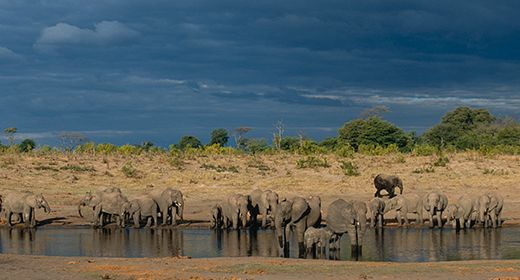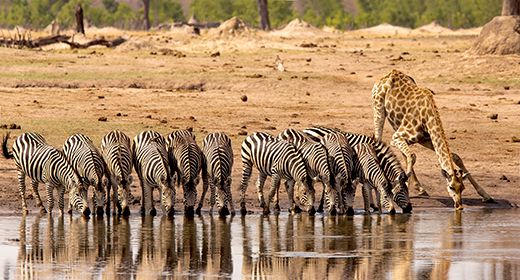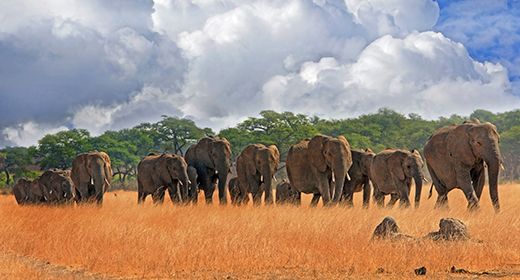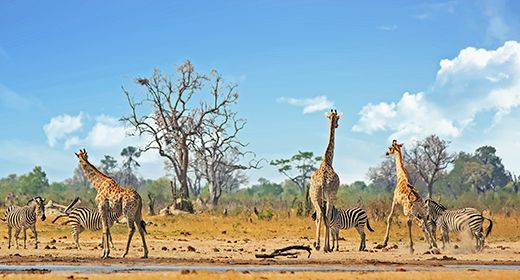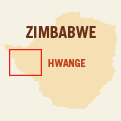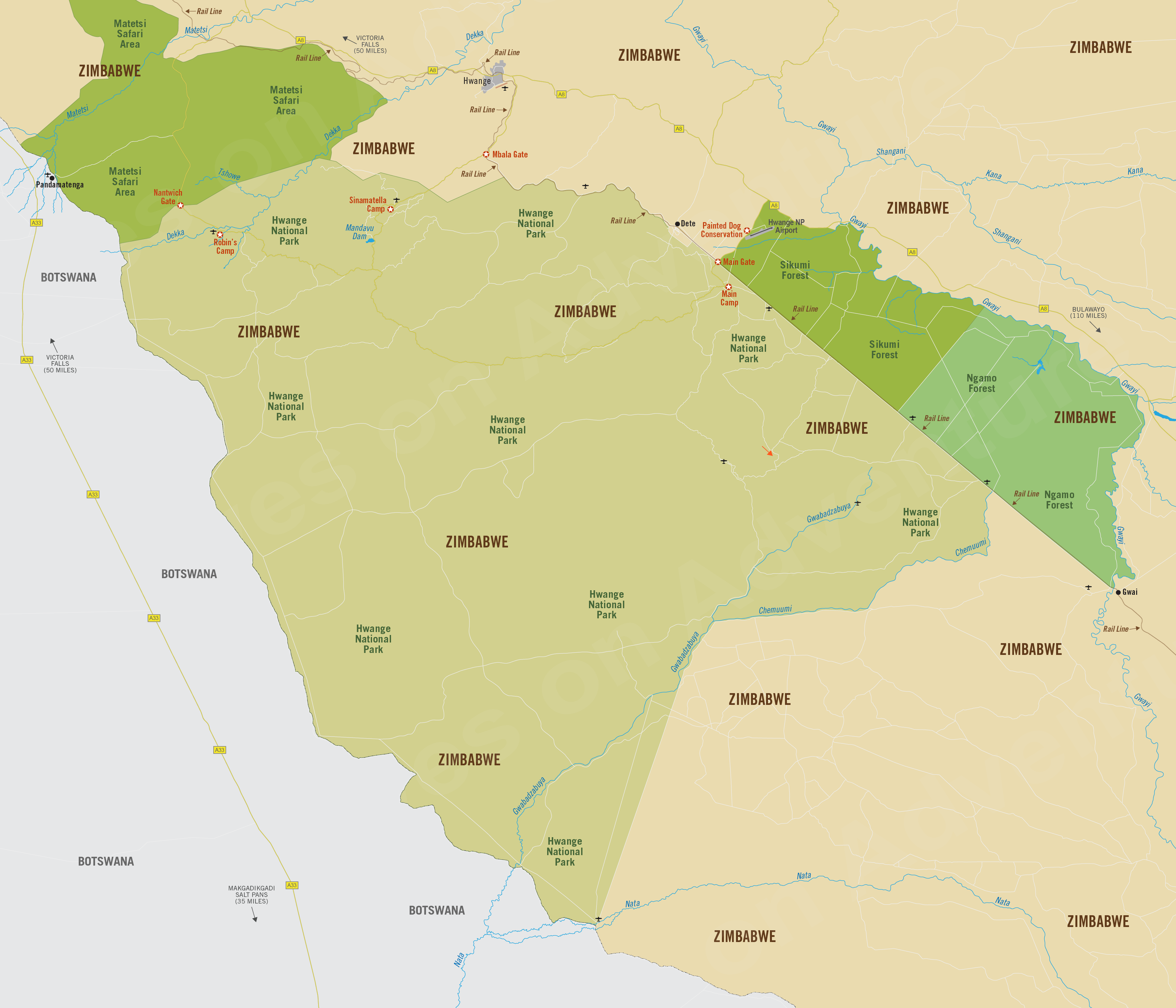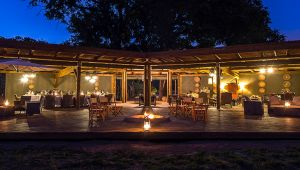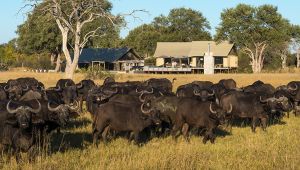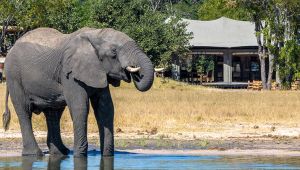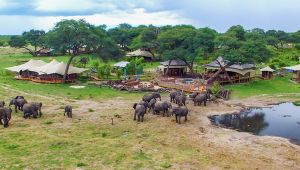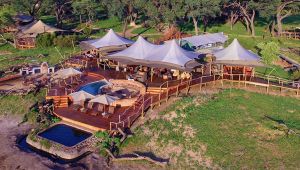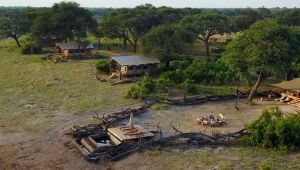Hwange
(incl. Hwange National Park, Matetsi Safari Area, Ngamo Forest, Sikumi Forest)
Region Links: Hwange, Lower Zambezi (Zimbabwe), Victoria Falls
Highlights
- Excellent safaris in Zimbabwe's largest national park.
- Diverse wildlife including Africa's Big Five animals.
- Wide array of accommodation, including world-class safari lodges.
- Easy to combine with both Victoria Falls and Mana Pools.
EOA Recommends: Linkwasha Camp, Little Makalolo Camp, Somalisa Acacia Camp, Somalisa Camp, The Hide Safari Camp
Hwange is Zimbabwe's largest national park and it offers exceptionally good wildlife safaris, with one of the densest populations of animals in all of Africa.
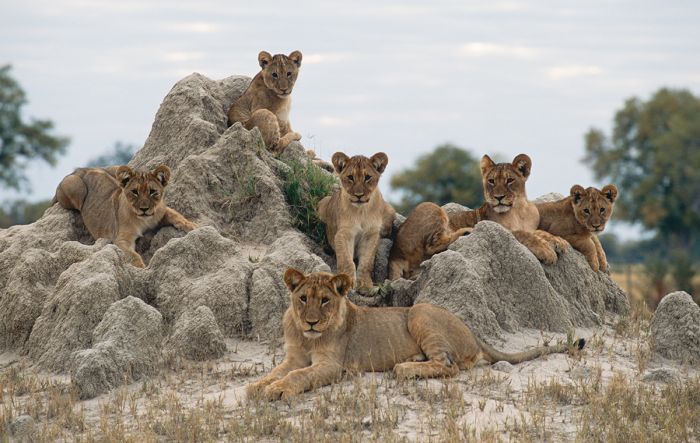
Lions on a termite mound in Hwange National Park (Copyright © James Weis).
Hwange (historically called Wankie by colonial settlers) has a long history of good game viewing, but 100 years ago, it was a mostly dry scrubland with very little water present during the dry winter months and thus only home to passing wildlife during the rainy summer months.
Today the park has over 60 man-made (but apparently natural when viewed) waterholes that are maintained by pump during the winter, providing a vital source of water for all the thirsty animals.
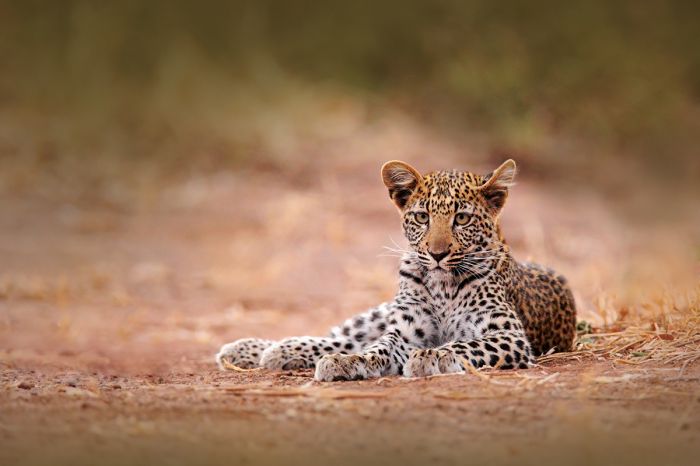
A juvenile leopard in Hwange.
The park is home to a variety of herbivores, including an abundance of elephant, buffalo, giraffe, impala, zebra, waterbuck, sable, and many more. Predator viewing is excellent, with good populations of lion, leopard, African wild dog, and spotted hyena, plus small numbers of cheetah. Hippos and crocodiles are found at many of the larger waterholes.
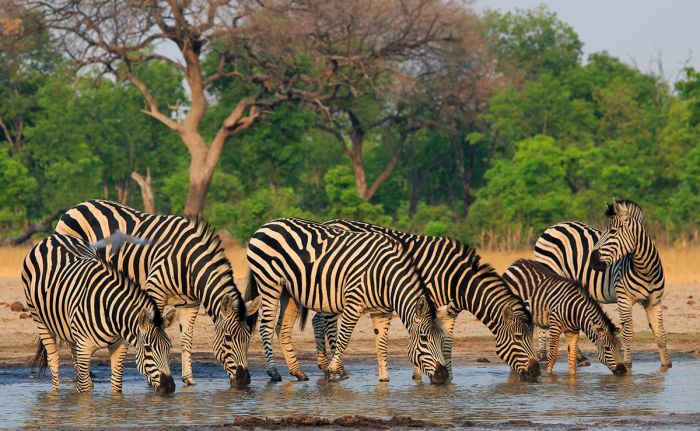
Zebras drinking at a waterhole in Hwange National Park.
The best game viewing is during the dry winter months (June through October), when the park's waterholes become a focus for large gatherings of wildlife coming to drink. The park offers a wide range of accommodation, ranging from self-camping to luxurious and all-inclusive safari lodges.
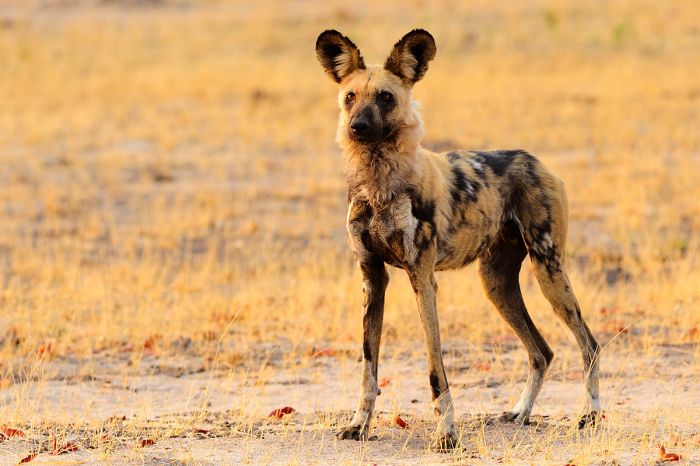
African wild dogs are one of Hwange's predators.
A popular northern Zimbabwe safari circuit includes a visit to Hwange National Park, Mana Pools National Park, and ending up at The Victoria Falls. Another option is combining Hwange with a safari in Zambia or Botswana.
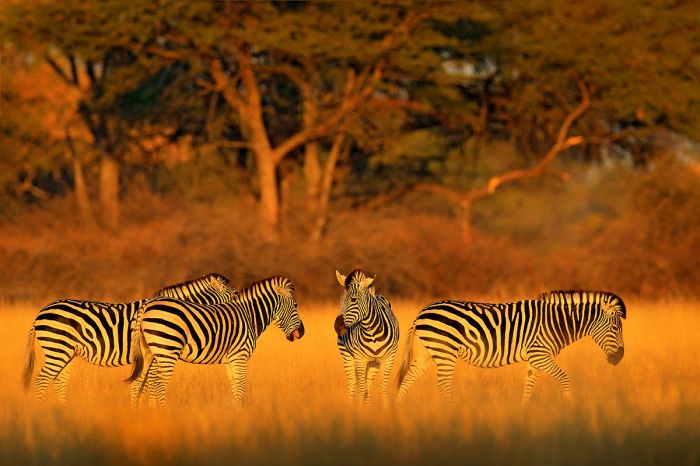
Zebras are one of Hwange's iconic species.
Read More...
Colonial Years, Game Reserve, Geography, History, Painted Dog Centre, Post-World War II, Ted Davison, Waterholes, Wildlife
History
Early History
Fossil discoveries prove that early hominids lived in the Hwange region as early as 2 to 3 million years ago. Stone tools dating back to around 50 000 years ago have also been excavated in the area, suggesting that our ancestors lived here throughout the Stone Age as well.
In more recent times, the hunter-gatherer Khoisan (or San) people assimilated with the Stone Age clans around 2 000 years ago. The San lived in the region for over 1 000 years until they were displaced by the much stronger and aggressive Matabele people.
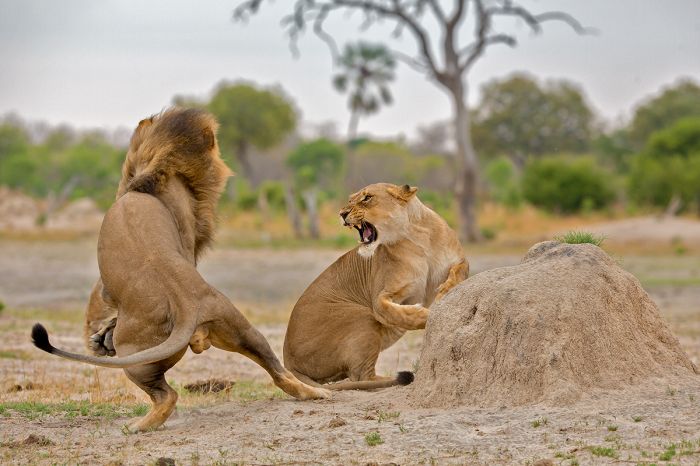
Lions consorting in Hwange National Park.
Colonial Years
In the late 1820s, Mzilikazi, then a lieutenant of Shaka (the king of the Zulu people who inhabited what is now northeast South Africa), had a dispute with his king and along with his followers, broke away from the Zulu kingdom. Mzilikazi and his followers became known as the Ndebele (or Matabele).
In the 1830s, under pressure from the Voortrekkers (European settlers who fled British rule in the Cape of South Africa), Mzilikazi moved his people north across the Limpopo River into what is now western Zimbabwe. This region, which includes Hwange, is known today as Matabeleland.
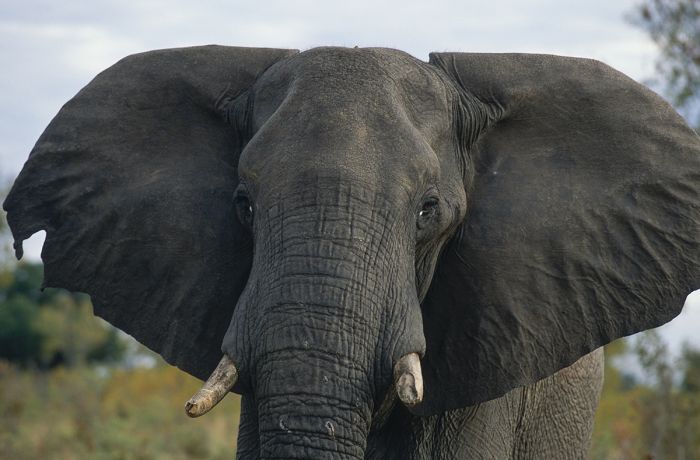
Elephants are abundant in Hwange (Copyright © James Weis).
The Hwange area was used throughout the rest of the 1800s and the early part of the 1900s as the royal hunting grounds of King Mzilikazi and later his son, Lobengula. The hunting of wildlife at this time was fairly limited and mostly for the subsistence of the Ndebele people.
The Ndebele were typically welcoming to most European travelers arriving in Matabeleland. Most of these travelers were hunters and explorers, one being David Livingstone.
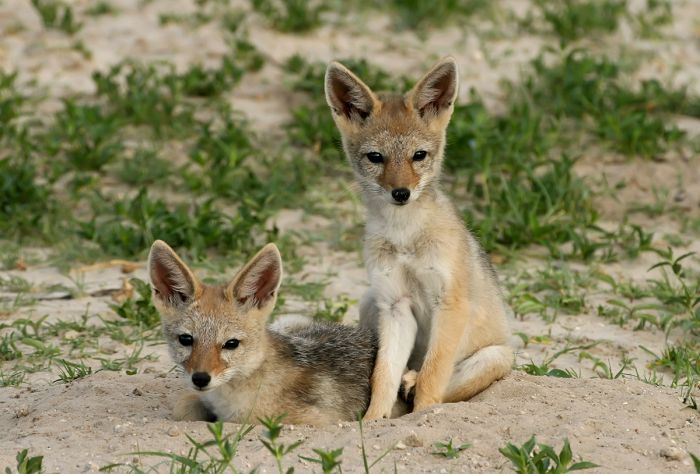
Black-backed jackal puppies in Hwange.
In 1889, Cecil Rhodes and his British South Africa Company (BSAC) negotiated with local chiefs (including Mzilikazi) to secure hunting and mineral rights on both sides of the Zambezi River. In exchange, the British offered protection from their tribal enemies.
The BSAC focused much of their work on obtaining minerals south of the Zambezi River and big game hunters began to arrive in numbers, seriously decimating wildlife, particularly elephants, which were killed to satisfy a huge demand for ivory.
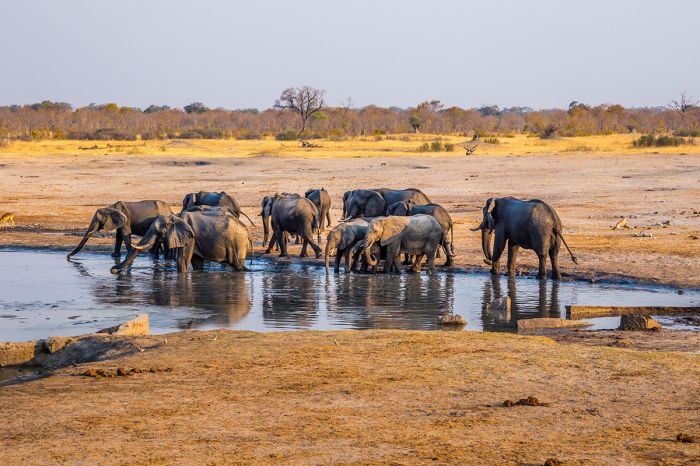
Hwange's pumped waterholes provide for wildlife during the dry season.
Game Reserve History
In 1923, the British declared the land that is present-day Zimbabwe a self-governing Crown colony called Southern Rhodesia. The lands across the Zambezi River to the north (present day Zambia) were also declared a colony of the British Empire (called Northern Rhodesia).
In 1926, South Africa declared that its Sabi Game Reserve would become the Kruger National Park and that same year, Rhodesia's Parliament decided that its country needed a game reserve as well. After a study to determine the most suitable land for the reserve (this was done primarily by consultation with hunters) and the Wankie District was chosen as the best land for the new reserve.
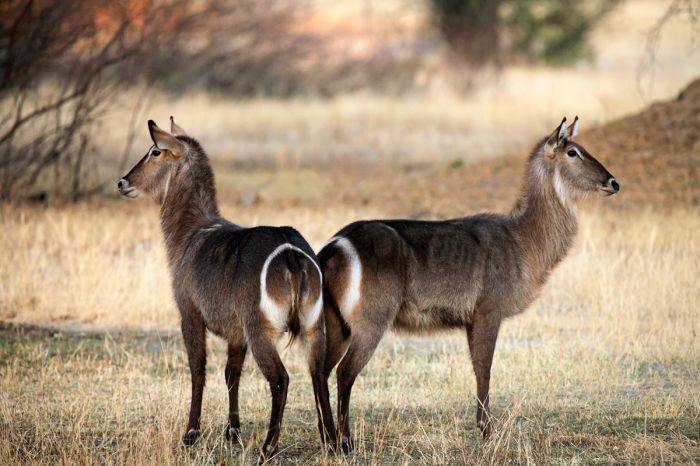
Common waterbucks in Hwange National Park.
The initial reserve was founded on the farm of H G Robbins, who after unsuccessfully trying to farm and raise cattle on his land, decided to convert his land into a wildlife sanctuary. Robbins handed over his property to the government in 1928 and additional lands surrounding his farm were incorporated into the new Wankie Game Reserve. The name comes from a local Ndebele chief named Hwange Rosumbani, but it was anglicized into 'Wankie'.
Ted Davison
A 22-year-old Rhodesian named Ted Davison was appointed as the reserve's first warden. During the initial years, Davison spent his efforts trying to eradicate tsetse flies from the reserve and so no infrastructure development occurred until around 1935.
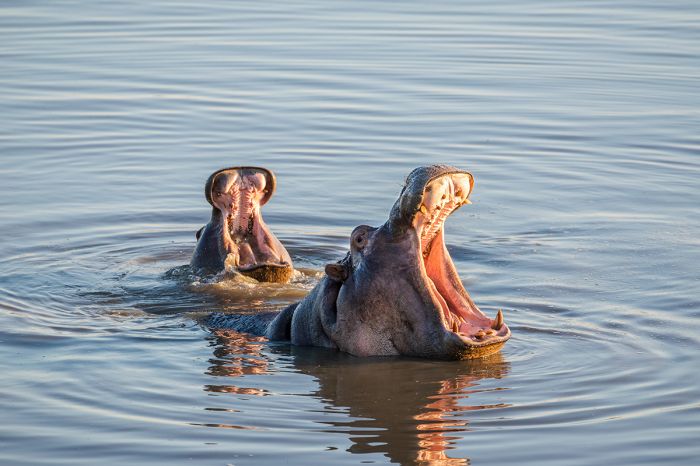
Hippos are common in some of Hwange's larger waterholes.
Wildlife in these early years was scarce, with only seasonal arrivals of elephant, kudu, sable, and roan, all of which are highly dependent on permanent water and so moved away during the dry winter months. Giraffe and impala were year-round residents. Wildebeest and buffalo were nonexistent and zebra very rarely seen. The reserve also had no roads. Both black and white rhino species were already hunted to extinction in the area. Due to the shortage of permanent water, there were no hippos.
A sad fact of the early years is that all four-legged predators, most notably lions, were reduced in number by hunting and trapping in order to increase the populations of the reserve's herbivore species and to reduce complaints of lost livestock by the neighboring farmers.
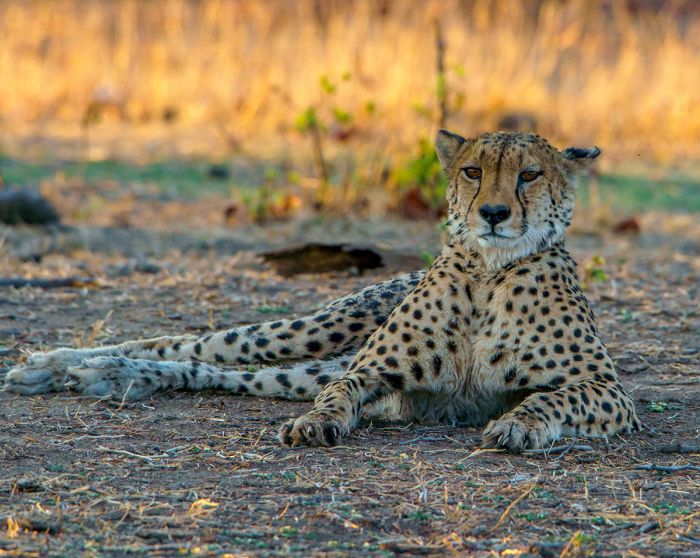
Cheetahs are one of Hwange's predators.
Waterholes
Although Wankie was bounded by rivers in the north, south and east, the vast interior of the reserve had precious little in the way of water to support wildlife at that time. In order to attract permanent wildlife to Wankie, Davison's team set to work in 1939, drilling the first of some 60 pumped waterholes, powered by windmills and supported by diesel pumps.
Over time and through trial and error, Davison was able to create a network of natural-appearing, circular pans throughout the reserve. Troughs were constructed to channel the pumped water to the pans, which began supporting a growing population of resident wildlife. Dams were added in some places to increase the water availability during the harsh dry season.
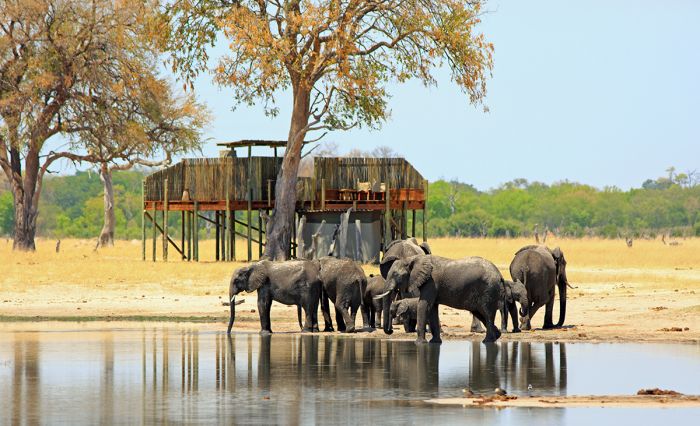
Elephants at Madison Pan, which has a raised viewing hide.
These waterholes became the focus of game viewing in the reserve, but most wildlife only showed up at night to drink. Viewing platforms with hides were constructed at some of the waterholes and Davison's guests would often sleep out on the platforms to wait for animals to appear after dark. Eventually, the animals became used to game viewing vehicles and the sounds of people on the platforms, making game viewing possible during the daylight hours.
New game drive tracks were added, connecting the pumped waterholes and allowing tourists to drive to the network of pans to see wildlife. Some roads, waterholes, and areas of the park were open only to Davison's staff, providing vast areas of the reserve that were available for wildlife to roam without encountering tourists. In those days, most tourists visited Wankie during the dry season (June through November).
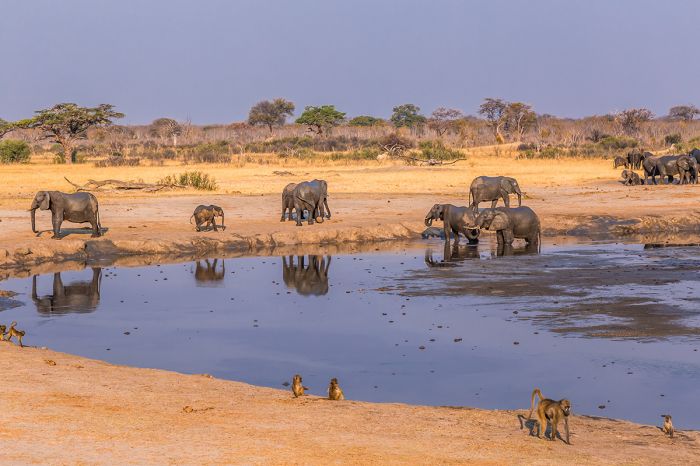
Hwange's pumped waterholes sustain its wildlife during the long, dry winter.
Wankie Game Reserve was proclaimed a national park in 1950. Tourist numbers were still very low at this time (around 3 000 per year), but by 1965, that number had increased to over 25 000. Although the first basic rest camp had been opened in 1933 (a mud hut camp) and some wood/brick huts under thatch had been added later, it was only after national park status that tourism really got underway.
In 1958, a hydro-power dam was built along the Zambezi River northeast of Wankie, creating the man-made Lake Kariba. It turned out that numerous black rhinos were stranded on islands in the newly filling lake and in 1961, Davison undertook an operation to dart and relocate the marooned rhinos and some others from the shores of the Kariba to Wankie. Some 50 rhinos were moved to Wankie from that operation.
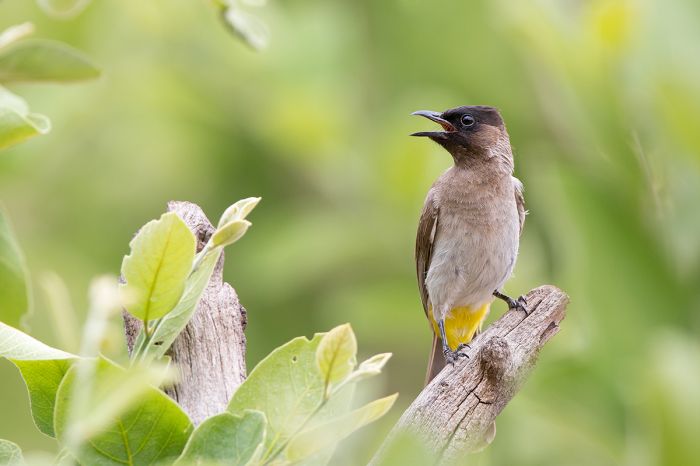
The common bulbul is one of Hwange's 400+ bird species.
Surprisingly, the first hippo appeared in the reserve at this same time, assumedly disrupted by the filling of Lake Kariba and wandering up one of the new lake's tributaries all the way to Wankie. The hippo took up residence in one of Davison's waterholes - Mandavu Dam. Soon after, more hippos arrived.
Other notable wildlife present at this time included elephant, giraffe, waterbuck, impala, greater kudu, bushbuck, zebra, duiker, tsessebe, reedbuck, steenbok, grysbok, ostrich, and eland. Oryx were also present as a seasonal migrant. Davison's waterholes helped increase the populations of these species and also attracted buffalo and blue wildebeest. Sable and roan antelope were found in small numbers.
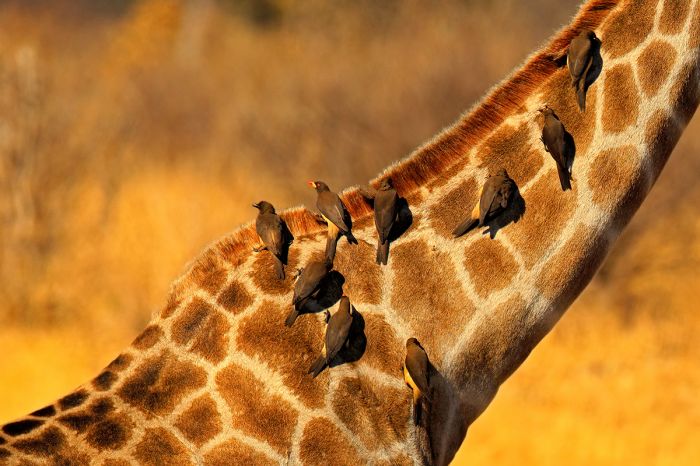
Red-billed oxpeckers removing parasites from a giraffe.
Post-World War II
During World War II, Wankie was closed due to lack of resources and fuel rationing. After the war, the park was somewhat deteriorated, with roads in disrepair and the animals, not having seen vehicles for years, very shy of people and vehicles. Nevertheless, the park experienced a huge boom in popularity and in 1950, over 4 000 people visited the park. Demand for accommodation far exceeded the supply of beds in the rest camps and the roads were suffering from the traffic. Game viewing was very good, with herds of 100+ elephants seen often.
During the 1950s, the roads in the park were cleared, repaired, and resurfaced with gravel. Davison's Main Camp (located at the present Main Gate) installed electricity from a new generator, and new staff housing was built. Bus tours to the park were started, departing from Victoria Falls and Wankie (Hwange) Town with a mechanic on board for the frequent breakdowns!
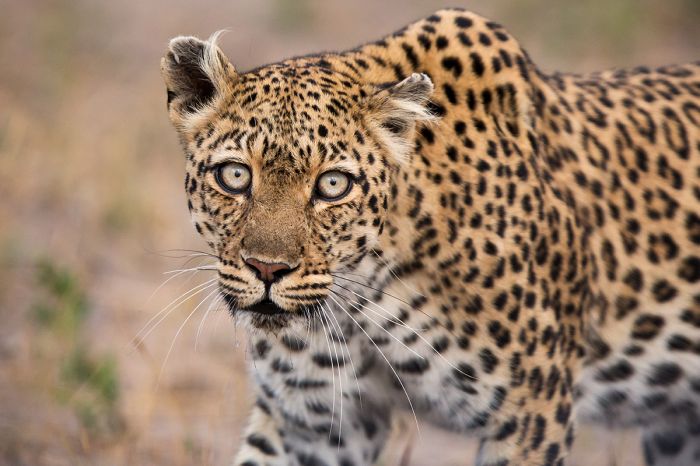
One of Hwange's leopards.
Ted Davison remained as warden of the park for 33 years until in 1960, he was promoted to become the country's second-in-command of the Rhodesian Department of National Parks. This was not a position Davison wanted, as he was forced to move from his beloved bush setting to an urban life in Salisbury (now named Harare), the country's capital. He later stated that this move was the worst thing that had ever happened to him.
During his tenure at Wankie, Ted Davison almost singlehandedly created the entire reserve. He explored it in its entirety, laid out the game track network, created the firebreaks, and selected the locations for the park's many waterholes (powered by windmills and later by diesel pump) to provide drinking points for the animals.
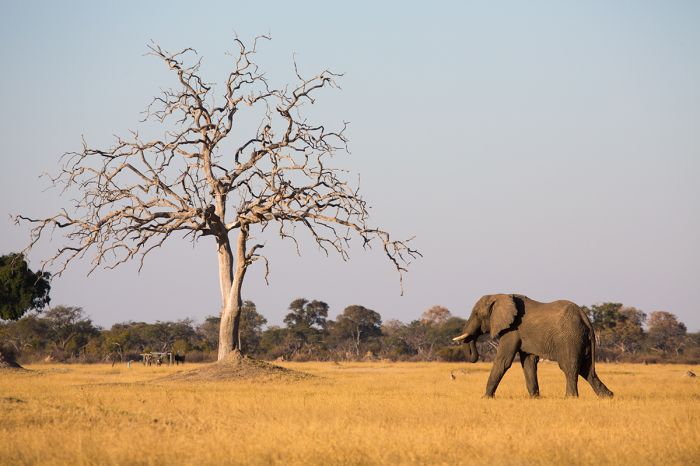
A bull elephant walks past a leadwood tree.
Davison also helped name many of the pans, seeps, and springs. He all but ended poaching in the park, increased its wildlife numbers and diversity, and stemmed the unchecked exploitation of the timber and wildlife in the park. He made Wankie one of the greatest wildlife sanctuaries in Africa, thus increasing international tourism to Rhodesia. By the late 1960s, Wankie had become a world-class wildlife destination.
In 1982, on the second anniversary of Zimbabwe's independence, the new government began renaming cities, towns, streets and other places in an attempt to remove the symbols of British colonialism and white minority rule. Some name changes were simply transliteration amendments to reflect the correct spelling in the local Sindebele dialect and Wankie was renamed as Hwange.
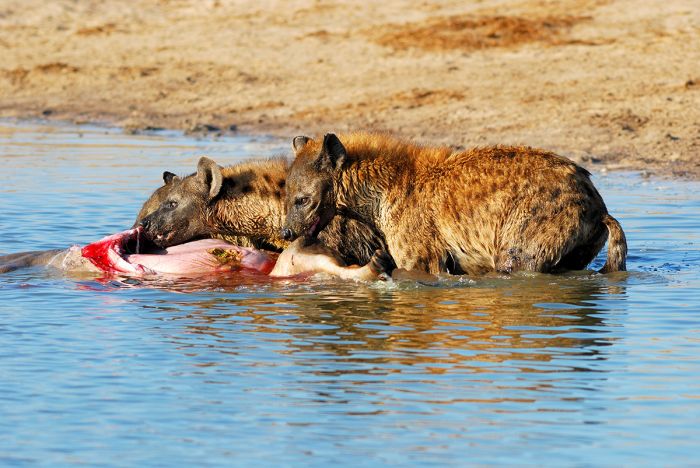
Spotted hyenas feeding on a kill in Hwange.
Geography
Hwange National Park covers 5 657 square miles (14 651 sq kms), making it Zimbabwe's largest national park, but about half of its area (in the central and southwest) is classified as the "Southern Wilderness" and this region is much less visited by safaris. The land in the wilderness area forms the far eastern edge of the Kalahari sands with sparse vegetation typical of a semi-arid desert and thus supporting less wildlife.
As one moves east through the park, the Kalahari sand gradually merges into mopane tree woodlands and then into a more lush region, supporting teak tree forests. These habitats support a much higher diversity and abundance of wildlife.
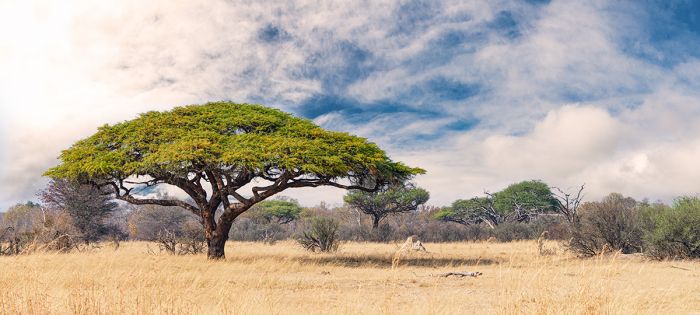
The Acacia tortilis tree (the "umbrella-thorn") is common in Hwange.
Due to habitat, the best game viewing and all the safari camps are concentrated in the north and east, broken into two general areas.
The Northern Sector includes the land around Robin's, Sinamatella, and Nantwich, extending east to the village of Dete on the border. The Eastern Sector includes the land around Main Gate, Main Camp and southeast to the park border. These two sectors have a selection of excellent all-inclusive safari lodges.
The Zimbabwe Parks and Wildlife Management Authority (ZPWMA) offer several low-budget accommodations with basic chalets, cottages, and campsites in the north and east sectors of the park. The most popular are Main Camp (located near Main Gate), Nantwich (at the Nantwich Gate), Robin's Camp, and Sinamatella Camp.
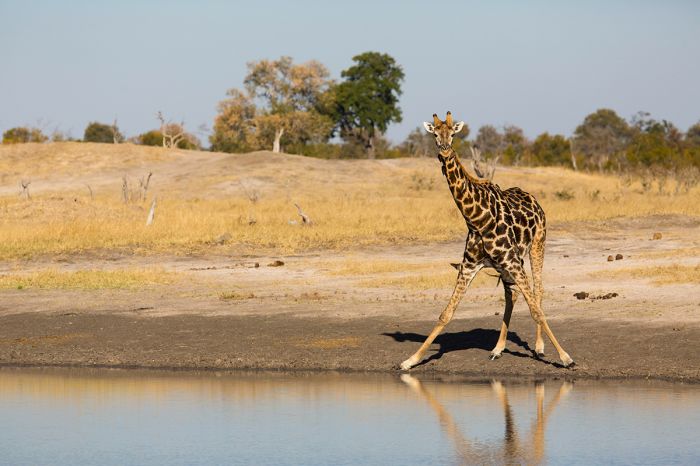
A giraffe getting some water in Hwange National Park.
The road network in the park is good, with tarred roads linking the north and east sectors and an extensive network of sand and gravel loops connecting the pumped waterholes and other wildlife viewing sites. Many of the borehole pans have platform hides to use for wildlife viewing.
Bordering Hwange to the east are the Sikumi and Ngamo Forests. These two regions are mixed-use land that are used mainly for commercial hunting. The Matetsi Safari Area borders Hwange on the northwest and is also used primarily for hunting safaris.
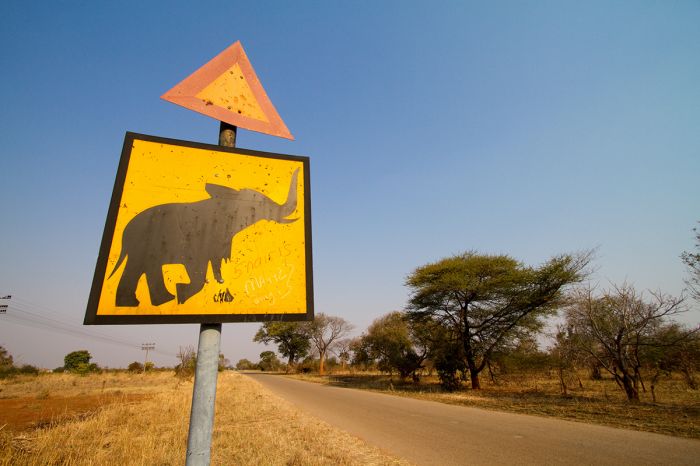
A road in Hwange National Park alerts drivers to watch out for wildlife.
Just north of the park is the original settlement of Hwange Town, which has been a coal-mining center since the days of Cecil Rhodes' British South Africa Company in the late 1800s. When the railway arrived here in 1904, coal production increased dramatically and the Hwange colliery became one of the world's largest. The town itself, with a population of around 34 000, offers nothing much of interest for visitors.
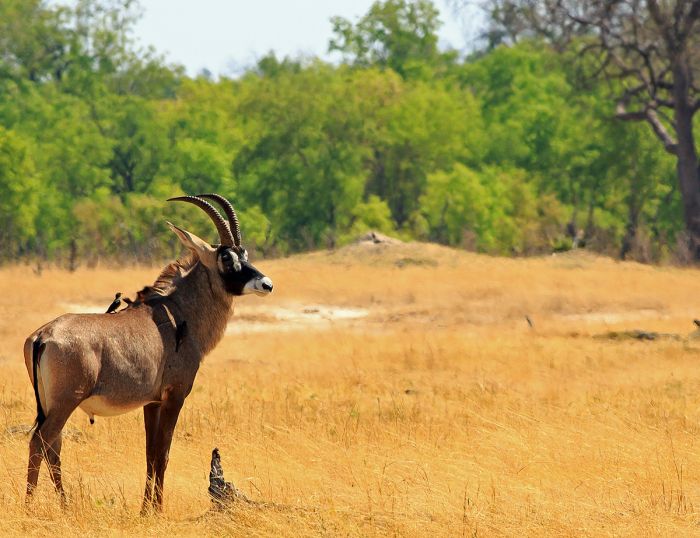
Roan antelope are present in good numbers.
Wildlife
Hwange's wildlife is most concentrated along the north and east sides of the park. This is also where the game drive roads are most developed and where the safari camps are situated.
Hwange is well known for its elephants, with big groups of multiple herds commonly encountered at the pumped waterholes during the dry season. Other commonly seen herbivores include buffalo, giraffe, zebra, blue wildebeest, greater kudu, impala, roan and sable antelope, reedbuck, waterbuck, tsessebe, red hartebeest, and warthog.
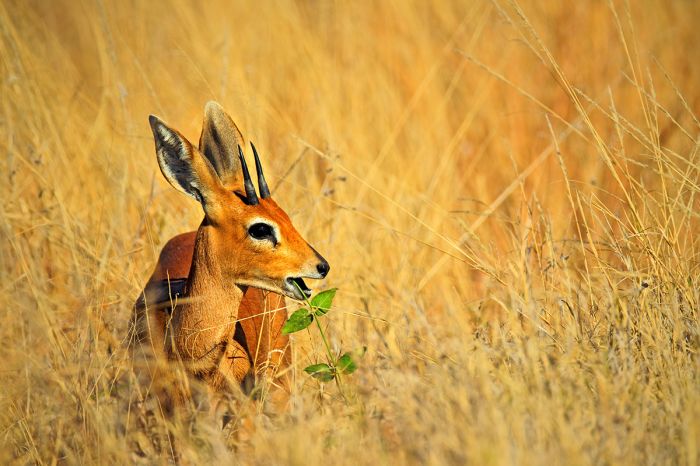
The diminutive steenbok is common in Hwange.
Hwange is also a great destination for predator viewing, with good numbers of lion, leopard, African wild dog, spotted hyena, and black-backed jackal. Cheetah are present in small numbers.
Once home to both black and white rhino species, Hwange's white rhinos (which were reintroduced in the 1980s after being poached out) are no longer present, having been lost to poachers. A few black rhinos still exist under very close guard by a rhino monitoring and protection team in the northern sector of the park.
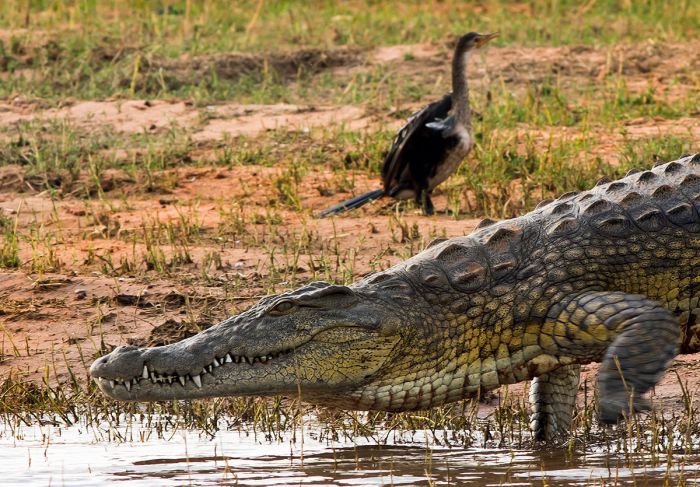
A crocodile at one of Hwange's waterholes.
Many of Hwange's waterholes (which are man made and maintained using borehole pumps) are home to hippos and crocs. Birding in the park is excellent, with over 400 species recorded.
Wildlife viewing is best during the dry winter months (June-November), when the animals are almost totally dependent on the network of pumped waterholes situated throughout the park. Self-drive visitors must be in their camp by 18:00, but staying in one of the private safari camps means that you can go out after dark and see some of the nocturnal species.
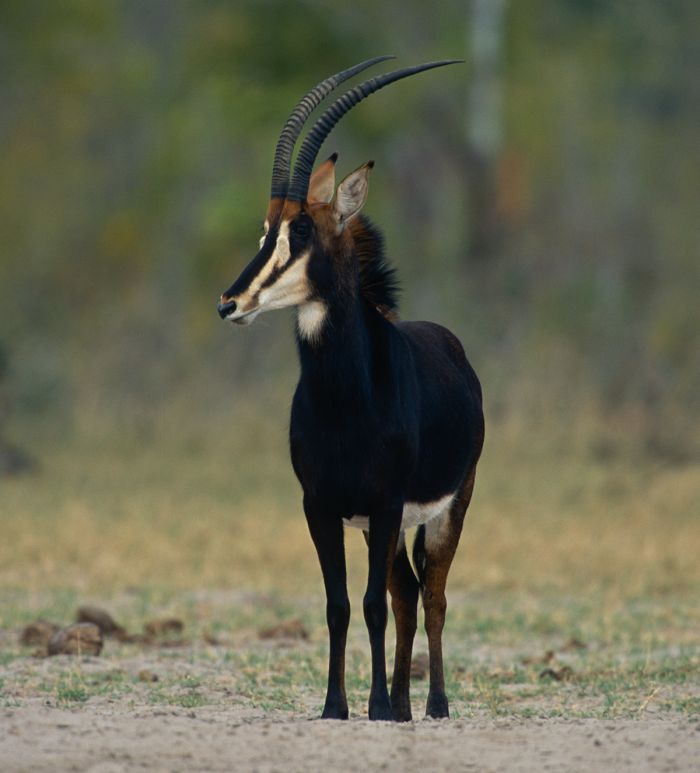
A sable antelope in Hwange (Copyright © James Weis).
Painted Dog Conservation Centre
African wild dogs (also called painted wolves or Cape hunting dogs) are one of Africa's most endangered species, with only 7 000 remaining in the wild. These entertaining and remarkable animals are a highlight for safari enthusiasts and they only exist in a few countries, including South Africa, Botswana, Zambia, Zimbabwe, Kenya and Tanzania.
An ongoing and long-running (since the mid-1990s) research and conservation project in Hwange operates out of the Painted Dog Conservation Centre, located just outside the Main Gate. The project employs over 60 people from local villages to run the centre's programs, which include research, conservation, education, and anti-poaching. There is also a Rehabilitation Facility where injured and orphaned dogs are treated before being returned to the wild.
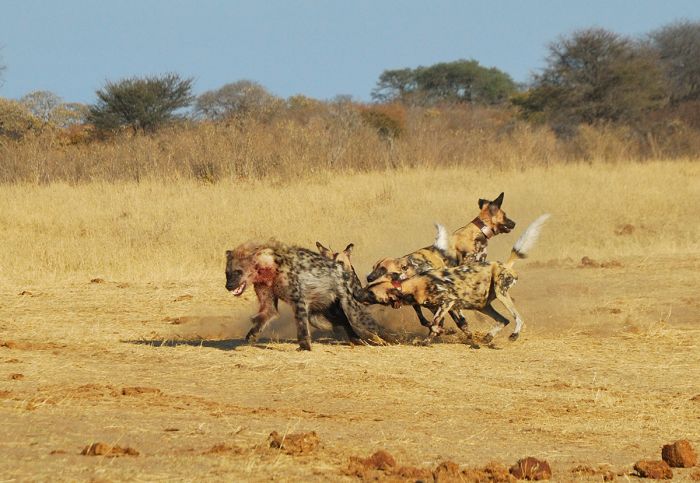
African wild dogs confront a spotted hyena in Hwange National Park.
Most wild dog deaths outside of protected areas are due to human causes, including snares, traffic accidents, and shootings, which are driven by public ignorance and prejudice against the species. There are only around 700 wild dogs remaining in Zimbabwe and the Conservation Centre typically monitors six packs on a daily basis in Hwange National Park, Mana Pools National Park, and elsewhere in the region.
The Painted Dog Conservation Centre is open to the public (every day from 8am-5pm), offering an interesting Interpretive Centre and viewing of any dogs being rehabbed at the time.
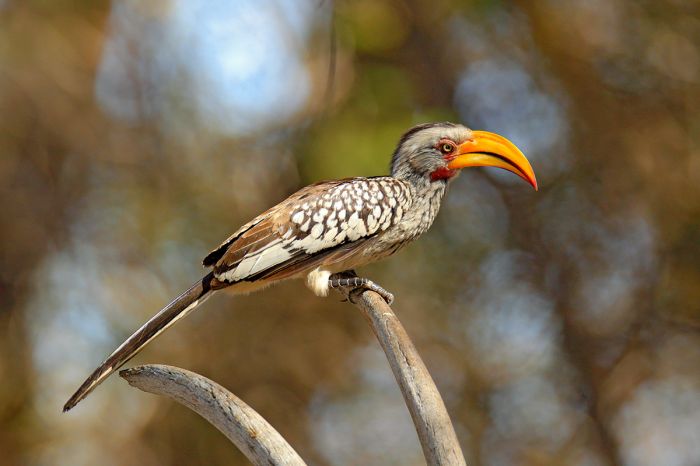
A yellow-billed hornbill in Hwange.
Read More...
Colonial Years, Game Reserve, Geography, History, Painted Dog Centre, Post-World War II, Ted Davison, Waterholes, Wildlife
Great Good Fair Poor
- Jan
- Feb
- Mar
- Apr
- May
- Jun
- Jul
- Aug
- Sep
- Oct
- Nov
- Dec
Hwange National Park experiences the rainy summers and dry winters that are typical of much of Southern Africa. The temperatures in Hwange range from mild to hot throughout the year, with the peak temperatures in October at the end of the dry season. The winter months of June thru October are best for game viewing, when wildlife congregates around the park's numerous waterholes, which are sustained by borehole pumps.
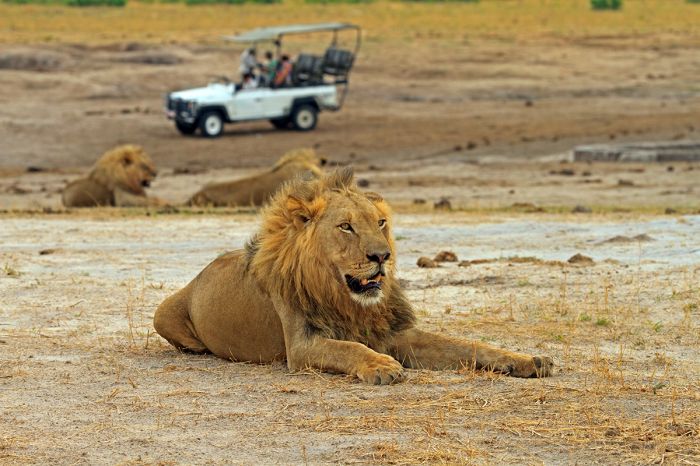
A coalition of male lions in Hwange National Park.
WINTER / DRY SEASON
The dry season in Hwange is from May thru October, with little to no rain falling during these winter months. The park has no naturally occurring permanent water, with the only rivers being seasonal in nature. In Hwange's early years, the park's first warden dug numerous boreholes to create dry season water sources and today it is those pumped pans that provide for its wildlife in winter.
The game viewing during these dry season months is at its best, with big herds of elephants, buffalo, and others visiting these waterholes throughout the day.
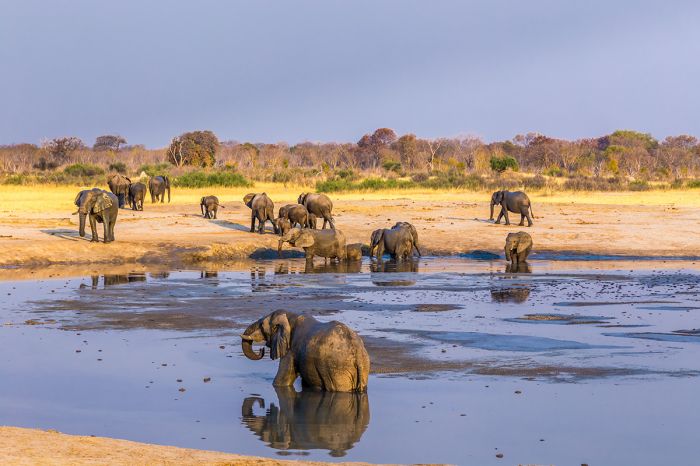
Hwange's waterholes are busy during the dry season.
May is the beginning of the dry season, with only a small chance of precipitation at the start of the month. The grass and bush is still lush and green after the long rainy season, but the days are typically sunny and pleasant, with average daytime highs of 76-82°F (24-28°C) and overnight temps dropping to 43-48°F (6-9°C).
June and July experience the lowest temperatures of the year and rain is rare to nonexistent. The grass and vegetation changes from green to brown and becomes almost totally dry by the end of July. Daytime temps are pleasant, but the nights are chilly or even cold. Daytime temps reach an average of 75-78°F (24-26°C), while nighttime temps fall to an average of 41-45°F (5-7°C). Wildlife viewing, especially at Hwange's waterholes, is exceptionally good.
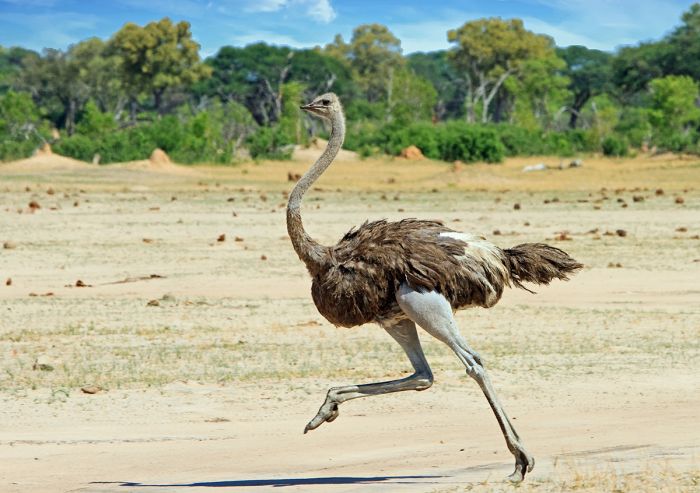
An ostrich runs across a dry Hwange landscape.
August and September are outstanding for game viewing in Hwange, with most waterholes active throughout the day. The grass and bush have become almost dry after months without rain and the days are sunny, with midday temps reaching an average of 82-90°F (28-32°C). Overnight temps drop to around 50-57°F (10-14°C). These are typically the busiest months in terms of tourists in the park.
October is the hottest month of the year, although early and welcomed rains can arrive by the end of the month in some years. Wildlife viewing is very good at or near any of Hwange's many waterholes, with animals coming to drink virtually all day. Daytime temps can be brutally hot, reaching an average of 90-98°F (32-37°C) and overnight temps only falling to 62-67°F (17-19°C).
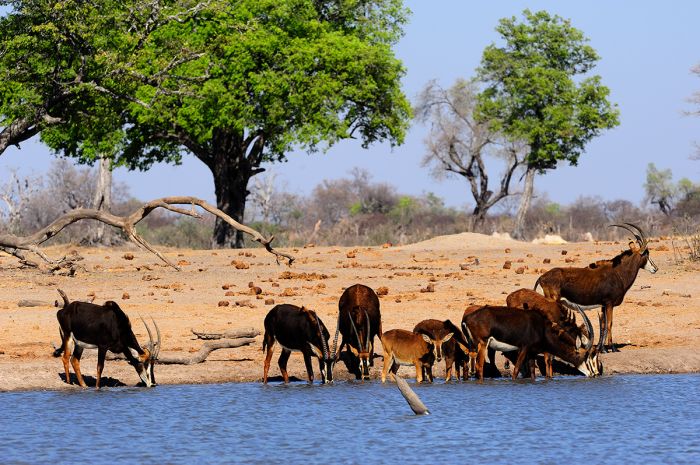
A herd of sable antelopes visits a waterhole in Hwange.
SUMMER / RAINY SEASON
Hwange's wet season begins in November and continues until sometime in April. Early rains sometimes occur in late October, but the heaviest rains fall in December, January, and February, with afternoon showers on most days. November is still a very good time to visit, with only occasional rains and lovely temperatures.
The rains transform the dry landscape and many herbivores give birth to coincide with the nutritious new grass, so there are lots of baby impalas, warthogs, and more. As the season progresses, wildlife disperses away from the park's waterholes, making it harder to find animals. Some roads can be challenging after heavy rains.
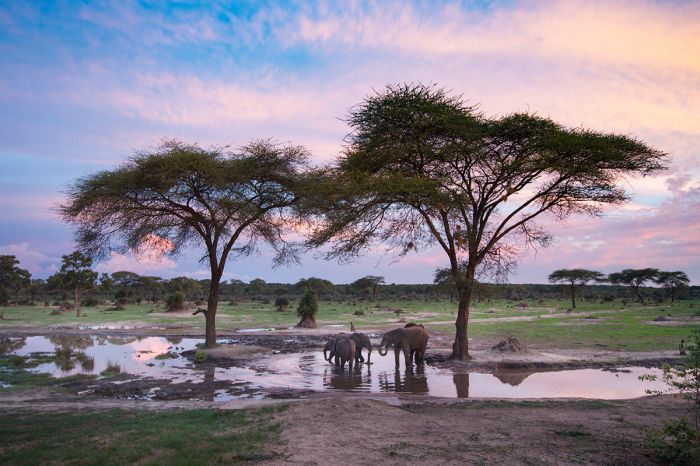
Fresh grass covers the dry land after early rains.
November is typically the first month to receive rain after the long dry winter. Following the first substantial showers, the dry and dusty landscape transforms almost overnight, with fresh grasses sprouting up, coloring the land in a verdant carpet.
Trees start to flower and the bush is alive with new life, including migratory birds arriving to breed. Game viewing is still good and the rains generally only fall every other day and usually as afternoon showers. Temperatures are warm, but moderated substantially when it rains, with daytime highs averaging 88-92°F (31-33°C) and overnight lows of 62-66°F (17-19°C).
December thru February are by far the rainiest months and wildlife is well dispersed into the bush, as they are no longer completely dependent on the park's pumped waterholes for water. Rain falls on most days, but rarely as an all-day event. The temperatures are warm, but cool down when it rains, with middays averaging 82-88°F (28-31°C) and overnights still warm at 64-67°F (18-19°C). Muddy conditions can make driving a challenge on the park's non-paved roads.
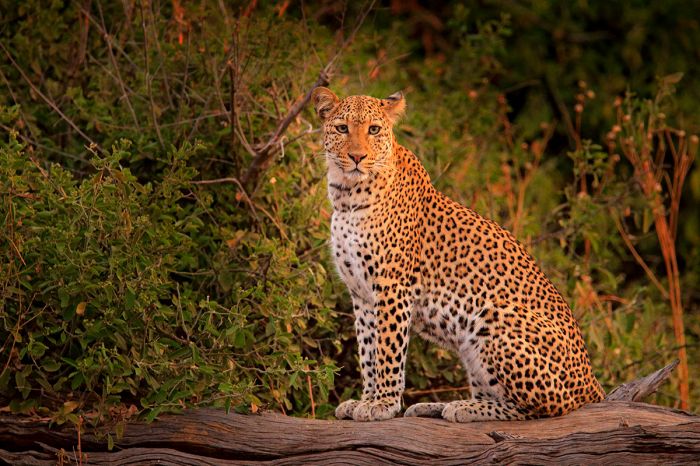
A leopard in Hwange National Park.
March is still rainy, but decreasing in frequency and no longer a daily event. The bush is very thick, the grass long and lush, and wildlife dispersed widely throughout the far reaches of the park. Temperatures remain warm, averaging 86-89°F (30-32°C) during the day and dropping to 58-62°F (14-16°C) overnight.
April marks the end of the rains, with only sporadic showers that taper off by month end. The landscape is green and lush, the grasses are very high, and the animals are healthy but still dispersed widely. The weather is pleasant, with plenty of sunshine and cooling temperatures. Daytime highs average 82-86°F (28-30°C) and overnights drop to 55-58°F (13-14°C).
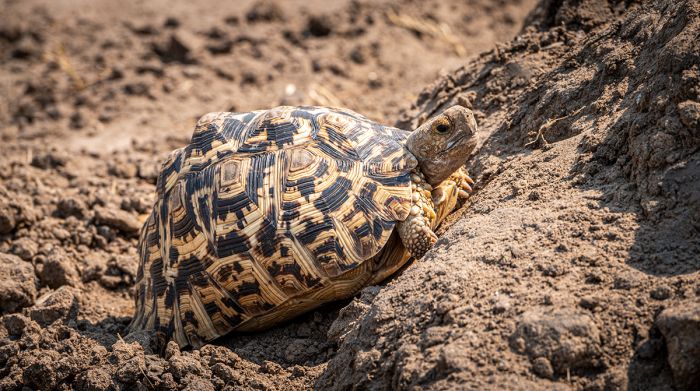
A leopard tortoise in Hwange NP.
Showing 1–6 of 6 results
An authentic, lower-cost bush camp located in a wildlife-rich private concession, giving guests a very exclusive experience. Activities include day and night game drives, walking, and cultural experiences.…
Located within a wildlife-rich private concession of Hwange, giving guests a very exclusive experience. Activities include day and night game drives, walking, and cultural experiences.…
A small and relaxed bush camp located in a wildlife-rich private concession, giving guests a very exclusive experience. Activities include day and night game drives, walking, and cultural experiences.…
Family-oriented, eco-friendly, upscale, tented camp overlooking a well-used waterhole in one of the park's best wildlife areas. Game drives, bush walks, sleep-outs at a platform hide, cultural visits, children's activities.…
Eco-friendly, tented camp overlooking a well-used waterhole in one of the park's best wildlife areas. Game drives, bush walks, sleep-outs at a platform hide, cultural visits. Up-close elephant viewing at the camp's 'elephant drinking pool'.…




